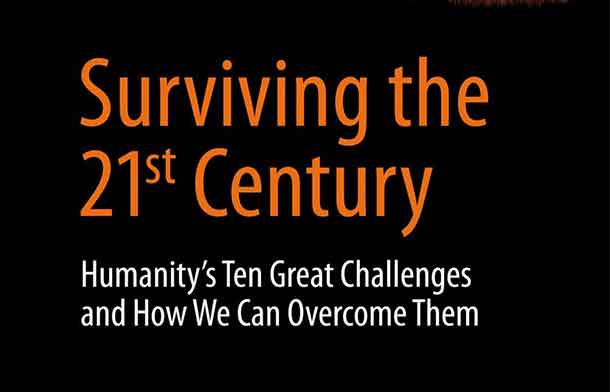Page added on March 5, 2017
Water Crisis Looming – Surviving the 21st Century

“Surviving the 21st Century” is a powerful new book exploring the main risks facing humanity: ecological collapse, resource depletion, weapons of mass destruction, climate change, global poisoning, food crises, population and urban overexpansion, pandemic disease, dangerous new technologies and self-delusion – and what can and should be done to limit them.
The world faces an acute water crisis within ten years, affecting food supplies, megacities and industry globally, a leading science writer has warned.
“World water use is already more than ten trillion tonnes a year. While the human population has tripled since 1950, our water use has grown sixfold,” says Julian Cribb, author of ‘Surviving the 21st Century’ (Springer International 2017). The book focusses on the ten greatest threats to the human future – one of which is resource scarcity – and what we can do about them.
“Rising demand from megacities, mining, agriculture and the fossil fuels sector in particular is combining with climate change to threaten major water scarcities across the world’s subtropical, arid and semi-arid regions. When this affects the food supply there will be vast migrations of people – like the world has never seen before.”
Mr Cribb says that scientific studies show:
• groundwater is running out in practically every country in the world where it is used to grow food, posing risks to food security in northern India, northern China, Central Asia, the central and western US, and the Middle East. Most of this groundwater will take thousands of years to replenish.
• the icepack on high mountain chains is shrinking, emptying the rivers it once fed in practically every continent.
• around the world, large lakes are drying up, especially in Central Asia, China, sub-Saharan Africa and the South American Andes.
• 50,000 dams break up the world’s rivers, sparking increased disputes over water between neighbouring countries
• most of the world’s large rivers are badly polluted with chemicals, nutrients and sediment.
Major Cities are at Risk
“The water crisis is sneaking up on humanity unawares. People turn on the tap and assume clean, safe water will always flow. But the reality is that supplies are already critical for 4 billion people – over half the world’s population. During times of drought, megacities like Sao Paulo, La Paz, Los Angeles, Santiago, 32 Indian cities and 400 Chinese cities are now at risk.”
Among world leaders, Pope Francis recently warned that we could be moving toward “a major world war for water”. He deliberately altered his prepared speech to issue this caveat when addressing an international seminar on the human right to water, hosted by the Vatican’s Pontifical Academy of Sciences on Feb. 23 and 24, 2017.
Each of the last three UN secretaries-general – Ban Ki-Moon, Kofi Annan and Boutros Boutros-Ghali – has warned of the dangers of world water scarcity and of ‘water wars’ in the future. The world’s leading scientific journal, Nature, issued a sobering warning of water scarcity under climate change in December 2013.
“Other than in water circles, these warnings seem to have passed largely unheeded by governments and the population at large,” Cribb says. “The sense of urgency necessary to prevent a world water crisis is not there.”
“Especially overlooked is the impact of water scarcity on the world food supply. As cities and energy corporations combine to rob farmers of the water needed to grow crops, the global irrigation sector is stagnating at a time when it needs to double food output to meet rising global demand for food. This will directly impact the availability and price of food to city people everywhere.
“We commonly assume that the natural hydrological cycle of evaporation and rainfall means there will always be ample water. In reality, we pollute and misuse water so badly, it is often not safe for drinking, domestic use or food production. Meanwhile rainfall, effluent and wastewater in most cities is wasted or discharged to the ocean.
“The average citizen of Planet Earth uses 1,386 tonnes of water per year, and the demand continues to rise every year, stressing supplies in many cases to their limits,” Cribb says.
A study by NASA (2015) shows that a third of the world’s major groundwater basins are stressed, and people are using the water without knowing when it will run out.
A timeline maintained by Professor Peter Gleick of the World Water Institute reveals the increasing frequency and tempo of disputes and conflicts over water globally.
“The evidence points to serious trouble for the world over water within the next ten years. The world focus of attention has been on climate – rightly so, as it is an integral factor in water scarcity – but the massive water crises that will disrupt food supplies and dislodge huge populations are much closer than other climate impacts. Present policy does not reflect this.”
Mr Cribb says it is time to put world water science, technology and management on a war footing, if the crises are to be averted. “Currently humans spend US$1.8 trillion a year on new weapons. If we spent a tenth of that on clean water technologies, fixing leaky supplies, recycling city water, measuring availability, agricultural water efficiency, effective water markets and controlling demand we could avoid the conflicts which the Pope and UN heads foresee.
“Current evidence suggests most countries prefer war to water.”
8 Comments on "Water Crisis Looming – Surviving the 21st Century"


onlooker on Sun, 5th Mar 2017 11:53 am
welcome to a century if we are lucky of relentless and increasing scarcity of everything we need to live
penury on Sun, 5th Mar 2017 11:57 am
World is running out of drinkable water. World soil is contaminated, forests are dying, other species are going extinct, oceans are warming and increasingly acidic destroying krill and plankton, corrals are dying large animals are dying off but hey humans continue to increase so everything is fine in our world. I do not thing that humans prefer war, but our “leaders” see war as a means to distract the serfs while the wealth and resources of the world flow to the elites.
BobInget on Sun, 5th Mar 2017 1:55 pm
No one can disagree.
We are running out of ‘conventional water’.
What’s new?
Scarcity caused by overuse/population explosion in mega cities, well documented.
One look at erratic patterns shows both anti historic devastating flooding and drought, often in the same regions.
Remedies?
Water is not oil. Water is not finite. Water can be ‘used’
and not ‘used-up’. ‘Recycled’ oil is contaminated friction reducing, lube oil. Oil converted to heat cannot easily be recycled.
‘Oil’ synthesized.
Synthetic oil is not distilled from crude oil. It’s made through a chemical process known as Fischer-Tropsch process, starting with raw materials like methane, carbon monoxide, and carbon dioxide.
Wasted water:
ONLY Drought conditions force us to conserve water.
Progress gets done recycling/conserving water during serious drought, not flooding.
Oil and gas pipelines follow populations.
The United States has more than 2.4 million miles of pipe. There are approximately 72,000 miles of crude oil lines in the U.S. that connect regional markets.
Pipeline101 – Where-Are-Pipelines-Located
http://www.pipeline101.com/where-are-pipelines-located
Water distribution pipelines:
The American Water Works Association calls it the Replacement Era. An estimated 1.9 million kilometers (1.2 million miles) of distribution pipes supply Americans with drinking water. How about agriculture?
AG pressure to build new and extend old.
Water pipelines provide a solution to areas lacking a continual and sustainable water source. These massive pipelines can transfer water quickly and effectively, avoiding evaporation which can occur in an open water transfer or diversion. With the incredible power of these pipelines, water can be extracted from deep within the earth through well pumping. Also, water can be directly taken from a surface water source. Water is transported through the pipelines with pumps and the natural force of gravity.
In the not too distant future, arid lands that are rapidly being developed will not be able to sustain their people or their land use practices. With 65% of all water use going towards irrigation, even more water will be needed for irrigation as growing regional populations will require increased agricultural production. Areas such as the southwestern U.S. are facing huge water shortages as urban sprawl continues to encroach on the desert. Water pipelines could transfer water to these areas to increase sustainability.
Sojuboy on Sun, 5th Mar 2017 5:48 pm
We’re already in deep shit. Ground waters are drying up. California is about done.
makati1 on Sun, 5th Mar 2017 6:25 pm
Another book ad filled with unrealistic dreams of “What if…” and “We can, IF…” pages. Just send some money to Amazon and it can be delivered to your doorstep tomorrow. Or … buy a good water filter. LMAO
Few humans will survive the 21st century, if any. It is too late for the ‘we shoulds’ to ever happen. The author’s dreams do not accept humanity’s greed, or take in its psychology. A million fools will waste their money on this book. The same who dream that tech will save them from themselves. Again, I LMAO.
Prep now and avoid the rush. Nothing YOU can do will change the future of humanity, but you might ease your own pain.
Sissyfuss on Sun, 5th Mar 2017 6:34 pm
I’m sorry but the water crisis will have to take a number and get in line. We are currently serving number 666. I believe that would be the Trump administration.
Davy on Mon, 6th Mar 2017 5:08 am
We have a population problem first and a water problem second. Don’t expect anything good to come out of water issues without some kind of population drop. We will need to drop the population by half in 20 years and another half in 10 as we stair step down the existential ladder of sustainability. One of the best gauges of the sustainability and survivability of your local is your relationship to water. Look around you and ask yourself what will happen if the grid becomes unstable? How is your water supply? If you are in a very large urban area you are likely in a very unhealthy place in this regards. We also need to extend that to food and your near local. If your food is shipped in from far away then you are likewise at risk. I am not talking discretionary foods these will be greatly reduced as soon as civilization drops into poverty. Can your local produce food within a reasonable distance. Water is the key to this part of the equation also.
Apneaman on Mon, 6th Mar 2017 11:30 am
Loss of regular reliable snow pack melt will negatively impact agriculture. Especially when those aquifers are empty.
Warm winter startles even the experts
“The forecasters said Minnesota was in for a cold, snowy winter. So much for that.
The skiers cried, the golfers high-fived, and the climatologists looked at the numbers in disbelief.
“I don’t think anyone saw that February would go down as one of the warmest Februarys on record,” said Kenny Blumenfeld, a climatologist with the Minnesota Department of Natural Resources.”
https://www.mprnews.org/story/2017/03/06/warm-winter-startles-even-the-experts